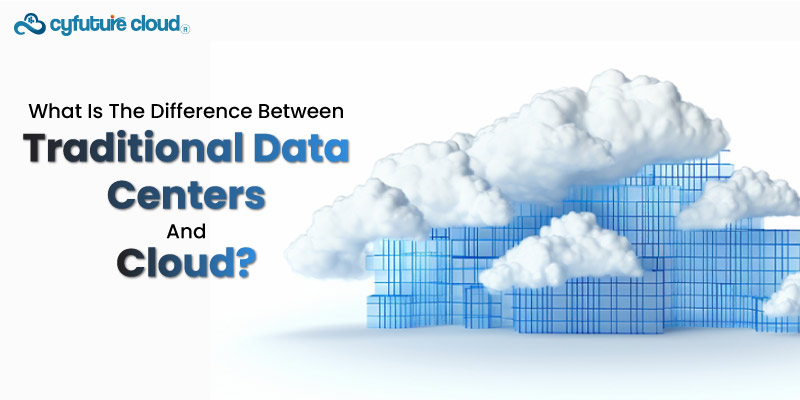Time to host your applications on cloud. Join Now
Time to host your applications on cloud. Join Now

Large businesses and organisations can store sensitive data, personal credentials, and essential programmes in a methodical and well-organized physical area called a data centre. Data centers are often built with a processing network and storage resources, such as rack space, that enable the sharing and storing of data and information.
The servers, storage systems, firewalls, routers, switches, and app-delivery controllers are the main parts of the data centre. Furthermore, you must be aware of its two main types—Cloud Data Centre and Traditional Data Center—in order to comprehend more about how it is classified.
We essentially expose you to these two main categories of data centers in this knowledge base section. In addition, we will contrast how does cloud computing differ from traditional data centres in terms of resource management. Also, determine which option is better for enhancing the speed, security, and efficiency of your data. Now let's get going!
According to the Infrastructure of a Service (IaaS) Model, a cloud data centre is built to provide cloud-based resources using already-existing hardware and storage resources. It is regarded as the most practical, scalable, and economical way for businesses to store their data in a neatly organised area.
Therefore, you may own a Cloud Data Centre that allows you to use cloud-based resources, rather than depending on other physical resources or third-party solutions. It would also be beneficial in building an infrastructure that is expandable and perfectly controls to satisfy the operational needs.
Cloud Data Centre charges for the services based on your needs. We provide you with comprehensive, scalable, and on-demand services as a result. Networking, computation, storage, and bandwidth are possible examples of the services. The computer IT infrastructure is closely integrated with all of these basic resources.
Delivering improved scalability choices to organisations without requiring significant capital outlays, additional staffing, or enormous amounts of space is the main objective of cloud data centres. Put simply, the Data Centre serves as the design platform for the whole cloud architecture.
These days, most firms choose and employ the improved technology known as traditional data centres. Traditional data centres provide you with a range of web hosting options, including shared, dedicated, and virtual private server (VPS) hosting, whereas cloud data centres provide you with an entirely autonomous cloud-based architecture.
A data centre may not host its platform online in this kind of facility. Rather, they would rather provide you a different hosting bundle. In addition, your data centre service provider offers 24/7 technical assistance and enhanced processing power.
Thus, you could be familiar with the basics of cloud computing compared to traditional data centres. Is your understanding still hazy, or may you have trouble distinguishing between the two? Be at ease! You will learn about all the fundamental distinctions between traditional data centres and cloud data centres in this section. Check out the table that is listed below:
Cloud vs data center: Which is better for your business?
A lot of businesses have been using the cloud lately to meet their infrastructure requirements. Small organisations may supply necessary computing resources through CDCs without having to recruit IT staff or handle expensive gear, making them a good option. Businesses that are large, rapidly growing, and web-based gain from cloud providers' efficiency, scalability, and experience. As a dependable layer of redundancy, the cloud is also a valuable tool for disaster recovery for many enterprises.
However, a significant portion of the infrastructure is still maintained on-site and is overseen by internal IT. Big, established companies with special use cases must handle dependencies more carefully, and as a consequence, they frequently discover that the traditional data centre is still a good option. Companies that value security and complete control over their data typically also require a traditional data centre.
Ultimately, a hybrid solution is often the optimal arrangement for commercial computer infrastructures. Businesses may leverage the benefits of cloud computing and on-premises data centres while avoiding their respective limitations.
Because of its scalability and cost, mission-critical systems may remain on-premises and under full business administration, with the cloud being used for backup or additional storage. While certain tasks are better suited for the cloud, others could work better with local infrastructure. In the end, a hybrid solution enables high-risk and secret information to be securely contained while processing and distributing public data quickly on the cloud.

Let’s talk about the future, and make it happen!